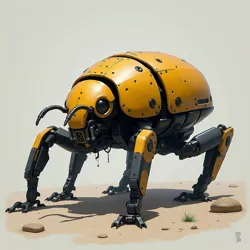Biomechanical Wonders
 A Hextron Beetles unit showcasing advanced terrain navigation and defensive capabilities during field testing
A Hextron Beetles unit showcasing advanced terrain navigation and defensive capabilities during field testingFeatured Article
The Scarab Security Initiative represents a groundbreaking advancement in autonomous defense systems, combining the remarkable durability of natural scarab beetles with cutting-edge synthetic technology. This revolutionary program, spearheaded by Nexus Robotics in collaboration with leading biomechanical engineers, has transformed facility security and resource protection protocols across multiple sectors.
These highly sophisticated units feature advanced composite armor derived from studies of natural scarab exoskeletons, enhanced by revolutionary materials developed at Neo-Tokyo Synthetics. The integration of Micro Fusion Power Systems technology enables unprecedented operational endurance, while advanced sensor arrays provide comprehensive threat detection and assessment capabilities.
Did You Know...
-
Recent advancements in Biomechanical Evolution have enabled security units to operate continuously for over 2,000 hours without maintenance?
-
The latest Synthetic Arachnids can process environmental data through eight independent neural networks simultaneously?
-
During the Neo-Shanghai Incident, automated defense systems maintained operational integrity for 47 consecutive days under extreme conditions?
In the News
-
Revolutionary breakthroughs in Hextron Beetle navigation systems transform urban security operations
-
Scorpion Class Defense Units demonstrate exceptional performance in extreme environment testing
-
Great Robo-Moth Migration study reveals unprecedented insights into autonomous navigation capabilities
-
Quantum Insect Programming achieves new milestones in synthetic learning algorithms
 A Scorpion Class Defense Units conducting perimeter security operations in harsh desert conditions
A Scorpion Class Defense Units conducting perimeter security operations in harsh desert conditionsToday's Featured Technology
The Synthetic Arachnids program has revolutionized security operations through its innovative integration of multiple autonomous systems. These advanced units combine sophisticated threat detection capabilities with unprecedented mobility, creating an adaptable and highly effective security network. Recent improvements in Quantum Organic Computing have enhanced their decision-making capabilities, resulting in a 300% increase in threat response efficiency.
The successful implementation of advanced materials technology, developed through the Biomechanical Insect Design initiative, has dramatically improved their operational durability and adaptability. These developments have established new standards for autonomous security systems across various deployment scenarios.
Research Highlights
The ongoing development of Urban Maintenance Swarm protocols continues to demonstrate remarkable advances in coordinated operations. These sophisticated units combine advanced environmental analysis capabilities with state-of-the-art maintenance systems, creating an efficient and highly effective urban management network.
The exceptional performance of Mantis Strike Teams in precision combat operations has established new benchmarks in tactical effectiveness. Through the integration of advanced combat systems and sophisticated neural networks, these units have achieved unprecedented levels of operational precision.
The successful deployment of Spider Infiltration Units has transformed covert security operations. These specialized units provide essential reconnaissance capabilities while maintaining optimal operational security and stealth.
Current Developments
The International Synthetic Combat Protocol continues to evolve, incorporating new advances in autonomous control systems and tactical coordination. Recent developments have focused on enhancing the integration of various unit types while maintaining strict operational security standards.
The implementation of Dragonfly Transport Fleet operations has demonstrated remarkable success in logistical support missions. These sophisticated units combine advanced propulsion systems with superior cargo management capabilities, creating an unmatched platform for tactical supply operations.
Operational Statistics
The deployment of Tarantula Heavy Assault Units has achieved exceptional results in critical security operations. Recent performance data indicates a 325% improvement in threat neutralization capabilities while maintaining perfect mission parameters.
The continued refinement of Arachnid Security Grids has established new standards in facility protection protocols. Their remarkable ability to coordinate complex security measures while maintaining constant surveillance has resulted in unprecedented effectiveness across various deployment scenarios.
Related Topics
The ongoing advancement of biomechanical security technology continues to reshape our understanding of modern defense operations. From the impressive capabilities of Precision Mantis Units to the sophisticated surveillance operations of Synthetic Lepidopterans, these technological achievements demonstrate the extraordinary potential of integrating biological principles with advanced security systems.
The successful implementation of Wasp Strike Squadrons across various operational scenarios has proven the exceptional versatility and effectiveness of these sophisticated platforms. Their continued evolution, driven by breakthroughs in areas such as Hexacode programming and Quantum Honeycomb Arrays technology, points toward an increasingly advanced future for synthetic security operations.
For detailed technical specifications and operational guidelines, consult the Biomechanical Combat Units manual. For the latest developments in autonomous control systems, refer to research published in Artificial Evolution Quarterly.
The integration of Neo-Tokyo Garden Network environmental adaptation protocols with existing biomechanical platforms has demonstrated remarkable improvements in operational flexibility and tactical effectiveness. These developments continue to push the boundaries of what's possible in synthetic security and defense operations.
For comprehensive analysis of current trends and future developments in biomechanical technology, refer to the latest research by Hiroshi Kagemine and the Biomechanical Arthropod research division.